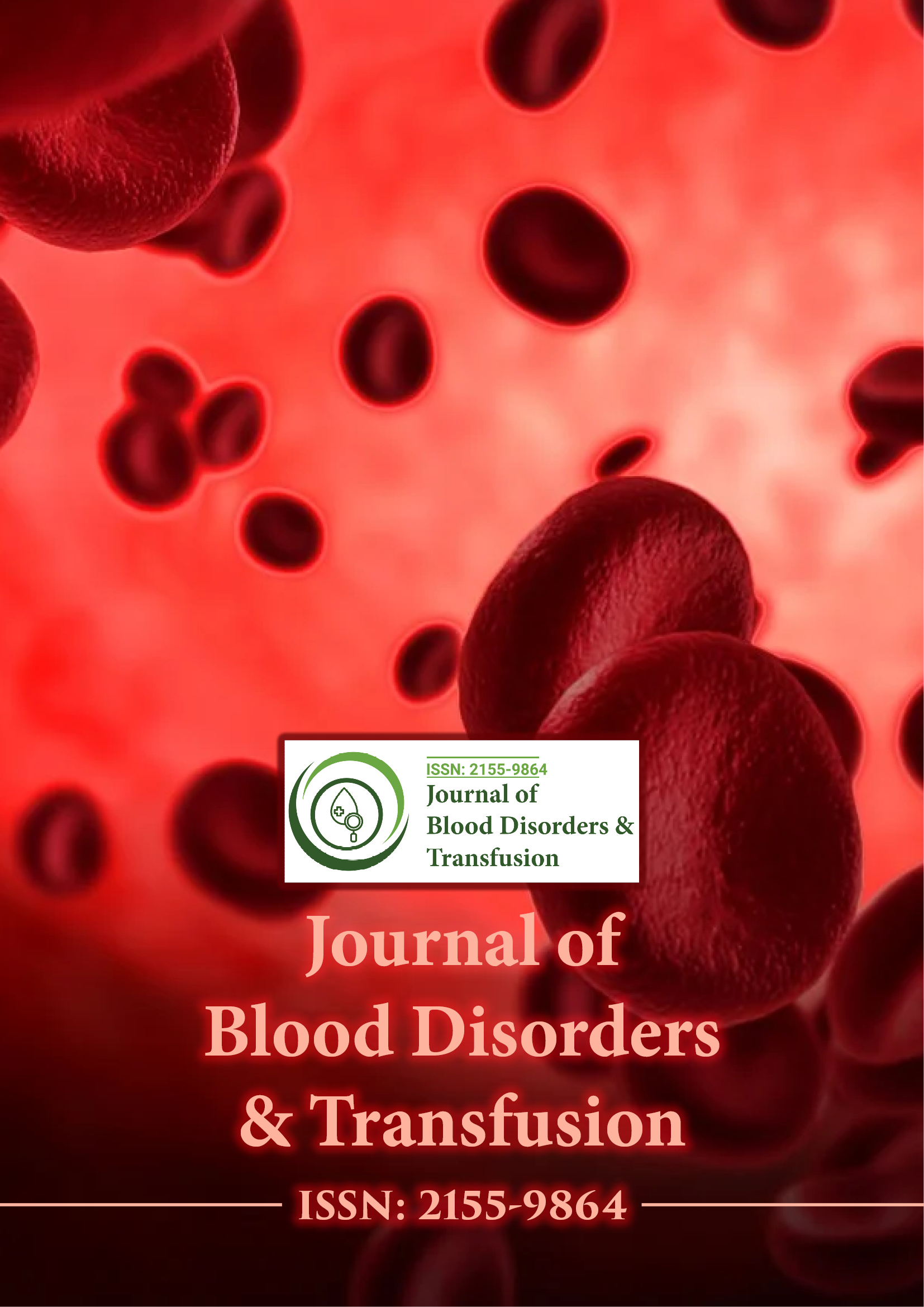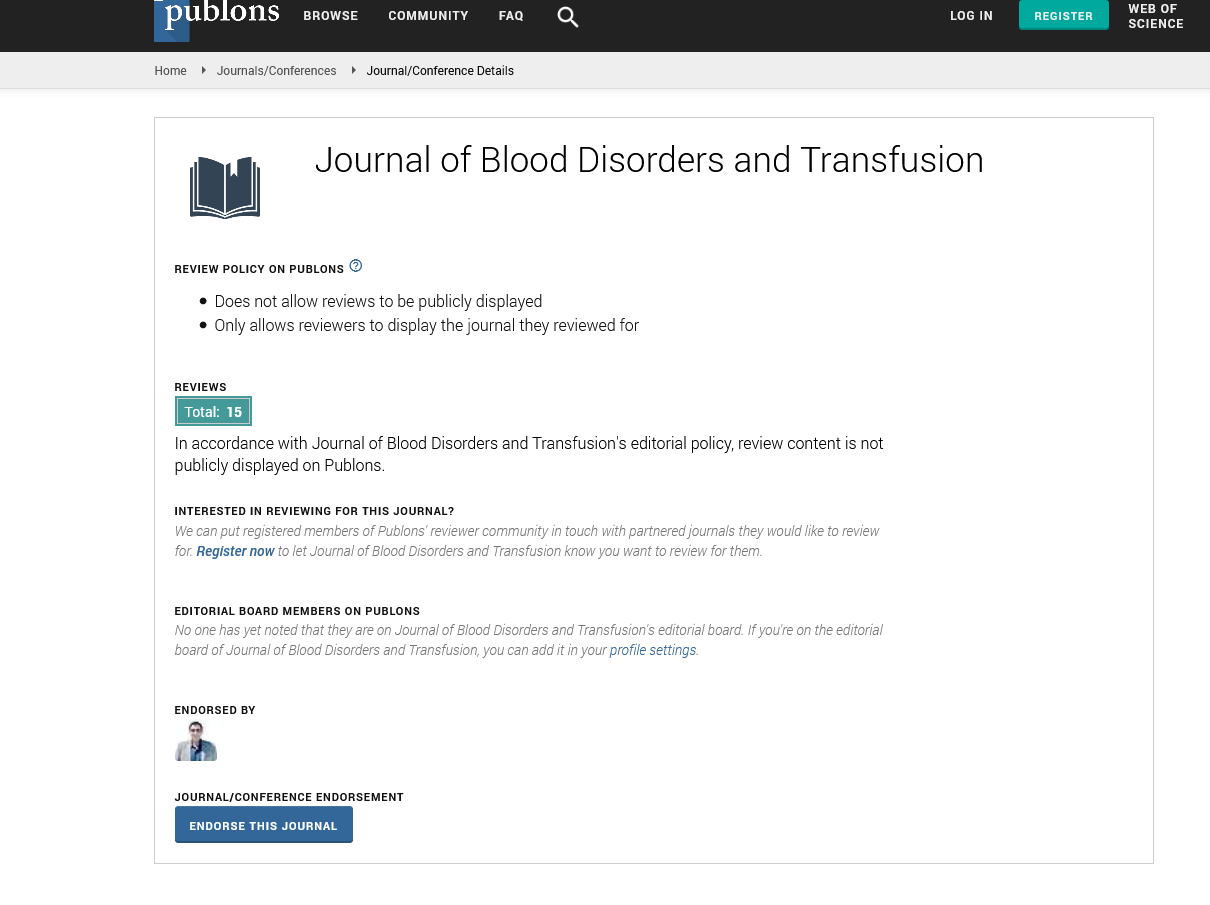Indexed In
- Open J Gate
- Genamics JournalSeek
- JournalTOCs
- Ulrich's Periodicals Directory
- RefSeek
- Hamdard University
- EBSCO A-Z
- OCLC- WorldCat
- Proquest Summons
- Publons
- Geneva Foundation for Medical Education and Research
- Euro Pub
- Google Scholar
Useful Links
Share This Page
Journal Flyer

Open Access Journals
- Agri and Aquaculture
- Biochemistry
- Bioinformatics & Systems Biology
- Business & Management
- Chemistry
- Clinical Sciences
- Engineering
- Food & Nutrition
- General Science
- Genetics & Molecular Biology
- Immunology & Microbiology
- Medical Sciences
- Neuroscience & Psychology
- Nursing & Health Care
- Pharmaceutical Sciences
Opinion Article - (2024) Volume 0, Issue 0
Transforming Hemolytic Anemia Care: The Role and Risks of Stem Cell Transplantation
Barnes Jung*Received: 26-Jul-2024, Manuscript No. JBDT-24-26841; Editor assigned: 30-Jul-2024, Pre QC No. JBDT-24-26841 (PQ); Reviewed: 14-Aug-2024, QC No. JBDT-24-26841; Revised: 21-Aug-2024, Manuscript No. JBDT-24-26841 (R); Published: 29-Aug-2024, DOI: 10.4172/2155-9864.24.S10.046
Description
Coagulation hemolytic anemia is a condition characterized by the premature destruction of red blood cells, leading to a shortage in the bloodstream and prompting the body to replenish these cells more rapidly than it can produce them. This condition can result from various factors, including genetic disorders, autoimmune reactions, or infections. Traditional treatments for hemolytic anemia include medications and blood transfusions. When these methods often bring temporary relief and may come with significant side effects. Recent advancements in medical research have saved the way for innovative approaches, with stem cell transplantation emerging as a promising solution. Stem cells have the unique ability to develop into various types of cells, including red blood cells, offering a potential for more lasting and effective treatment options for hemolytic anemia. The role of stem cell transplantation in treating hemolytic anemia involves replacing damaged or defective cells with healthy ones derived from the stem cells of the patient or a compatible donor. This method aims not only to alleviate symptoms but also to address the underlying causes of the disease. By focusing on the regenerative capabilities of stem cells, researchers hope to provide better outcomes and improved quality of life for patients suffering from hemolytic anemia. Considering the complexity and impact of hemolytic anemia, understanding the advancements in stem cell transplantation is important. This approach not only represents a shift from traditional therapies but also signifies a move towards personalized medicine, where treatments are tailored to the individual needs of patients. As this field continues to evolve, it holds immense promise for transforming the landscape of hemolytic anemia treatment.
Hemolytic anemia is a condition characterized by the premature destruction of red blood cells. One innovative approach to treating this condition is stem cell transplantation. This treatment offers a potential cure, especially for patients with severe or refractory cases of hemolytic anemia. Stem cell transplantation involves replacing the damaged bone marrow, which is responsible for producing defective red blood cells, with healthy stem cells. These healthy stem cells can be sourced from a matched donor or, in some cases, the patient themselves. The primary goal is to establish a new, healthy blood cell production system capable of producing functional red blood cells. The transplantation process typically starts with conditioning therapy, which involves chemotherapy or radiation to eliminate the patient's defective stem cells and make room for the transplanted ones. Following this, the healthy stem cells are infused into the patient's bloodstream, where they migrate to the bone marrow to begin producing new blood cells. After the stem cell infusion, patients enter a critical recovery phase. During this period, new stem cells engraft and start producing healthy blood cells. Close monitoring is essential to manage potential complications, such as infections or Graft-Versus-Host Disease (GVHD), where the transplanted cells attack the patient's body. Stem cell transplantation offers several advantages for treating hemolytic anemia. It can provide a long-term cure and significantly improve the quality of life for patients. The procedure carries risks and requires a carefully matched donor, strict medical supervision, and a supportive care system to manage post-transplant complications. Ongoing research in stem cell technology continues to refine this treatment, aiming to reduce risks and improve outcomes. Advances in gene editing and personalized medicine may further enhance the effectiveness of stem cell transplantation for hemolytic anemia in the future. Stem cell transplantation represents a promising and innovative approach for treating hemolytic anemia. By replacing defective stem cells with healthy ones, this procedure offers hope for a cure and a better quality of life for patients suffering from this challenging condition.
Challenges and risks of stem cell transplantation is a severe condition that affects the red blood cells, leading to their premature destruction. Stem cell transplantation has emerged as a promising treatment. However, it comes with various challenges and risks that must be understood. Graft-Versus-Host Disease (GVHD) one of the most significant risks of stem cell transplantation for hemolytic anemia is Graft-Versus-Host Disease (GVHD). This condition occurs when the donor's immune cells attack the recipient's body, leading to complications ranging from mild to life-threatening. Preventing and managing GVHD is important for the success of the transplantation.
Patients undergoing stem cell transplantation for hemolytic anemia are at an increased risk of infections. The high-dose chemotherapy or radiation therapy used to prepare the body for transplant weakens the immune system, making it susceptible to bacterial, viral, and fungal infections. Monitoring and preventive measures are essential to protect patients during this vulnerable period. Engraftment failure is another challenge, where the transplanted stem cells do not grow and develop as expected in the recipient's bone marrow. This failure can result in prolonged periods of low blood cell counts, increasing the risk of infections, bleeding, and anemia. Ensuring a suitable match and optimal conditions for transplantation are critical to overcome this risk. Even after successful transplantation, patients with hemolytic anemia may face long-term complications. These can include chronic GVHD, organ damage, and secondary cancers. Regular follow-up care and monitoring are necessary to manage these risks and maintain the patient’s health post-transplant. The process of stem cell transplantation raises ethical and socioeconomic issues. The availability of suitable donors, the high cost of the procedure, and the accessibility of treatment are significant concerns. Addressing these issues is major to making stem cell transplantation a viable option for more patients with hemolytic anemia.
Citation: Jung B (2024). Transforming Hemolytic Anemia Care: The Role and Risks of Stem Cell Transplantation. J Blood Disord Transfus. S10:046.
Copyright: © 2024 Jung B. This is an open-access article distributed under the terms of the Creative Commons Attribution License, which permits unrestricted use, distribution, and reproduction in any medium, provided the original author and source are credited.

